X-RAY RUNS: Apply for Beamtime
2017 Nov 1 - Dec 21
2018 Feb 7 - Apr 3
2018 Proposal/BTR deadline: 12/1/17
2018 Apr 11 - Jun 4
2018 Proposal/BTR deadline: 2/1/18
 |
| Issue No. 2 | 2014.01.15 |
 |
From the Director
CHESS accepting active NSLS proposals: After a decade of planning, designing, and preparing, we are all eager for the commissioning of NSLS-II. NSLS-II will significantly expand the frontiers of science enabled by coherent x-ray beams. An unavoidable consequence, however, is that many current NSLS users need to find homes for their research programs during the "dark period." The new undulators (to be installed this summer), a new suite of state-of-the-art area detectors, and our East Coast location make CHESS a very attractive choice for many current NSLS users. more » |
|
REU Program Deadline: February 2, 2014 |
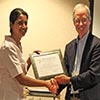 |
Annual CHESS $1,000 student research paper prize CHESS announces the 2014 CHESS Student Research Paper Prize of $1,000 to be awarded to the best student paper published in 2013. The paper must be based in part on data collected at the Cornell High Energy Synchrotron Source, and the first author on the paper must have been a graduate or undergraduate student when the paper was submitted. more » |
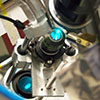 |
Measuring reaction kinetics in protein crystals with confocal microscopy Confocal microscopy is a powerful tool for imaging a variety of biological samples, including protein crystals. In addition to the ability to generate 3D reconstructions of the sample in question via optical sectioning, confocal microscopy can also be used to measure reaction kinetics in the fluorescence mode. more » |
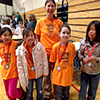 |
Robotics for girls: A grad student's perspective LEGO robotics? Not my thing. When Lora Hine, director of educational programs at the Cornell Laboratory for Accelerator-Based Sciences and Education, asked me to co-coach a FIRST LEGO League (FLL) team this past fall, I hesitated. After all, when I was a kid, I would never have joined a robotics team. I had no interest in gadgets ... more » |
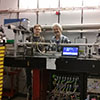 |
New BioSAXS beamline, dedicated lab space, new equipment! The FALL 2013 commissioning of G1 line as the new home for BioSAXS far exceeded our expectations! Beam stability was rock solid and we were able to routinely collect data below q = 0.006 A-1 at a faster pace than ever! The G1 beamline control area has been renovated and reorganized to make more efficient use of space and to accommodate larger groups. The G-line chem room, which has a dedicated BioSAXS sample preparation area, now has high-quality ultrapure water on tap and all the equipment you need to prepare a wide variety of buffers. more » |
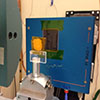 |
New CdTe pixel-array-detectors for high-energy diffraction at A2 CHESS has recently acquired and commissioned a lightweight, high-resolution, high dynamic range area detector ideally suited for hard x-ray reciprocal space mapping of single crystal samples. The "PiXirad-1" module mounts easily on the 4-circle diffractometer at the A2 endstation, and is fully integrated into SPEC control. First-ever synchrotron tests and user experiments using the PiXirad were performed at CHESS during 2013. more » |
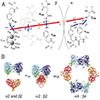 |
Radicals can be stabilizers: Trapping an active ribonucleotide reductase complex Ribonucleotide reductase (RNR) is essential for DNA synthesis and cell proliferation. RNR is an enzyme that catalyzes the conversion of nucleotide diphosphates (NDPs) to deoxynucleotide diphosphates (dNDPs), the building blocks of DNA. RNR plays a critical role in regulating the total rate of DNA synthesis, which is necessary to maintain the constant DNA to cell mass ratio during cell division and DNA repair. The reaction is strictly conserved in all living organisms and proceeds via a free radical mechanism of action. more » |
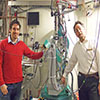 |
Angel Rodriguez-Fernandez commissions new diffractometer at C-line CHESS just installed a new HUBER 6-circle diffractometer (illustrated below) in the C-line (bend magnet) experiment hutch. It replaces the original (30 year old) CHESS 4-circle, and provides many new capabilities. This system weighs 4600 pounds together with its support table engineered by Alan Pauling, based on an APS Sector 7 design. The table was built for CHESS in New York State, by Keller Engineering in Buffalo. more » |
The Cornell High Energy Synchrotron Source (CHESS), a national user facility, is supported by the National Science Foundation and the National Institutes of Health/National Institute of General Medical Sciences under NSF award DMR-0936384. CHESS is operated and managed for the National Science Foundation by Cornell University. |
| © 2014 CHESS. All Rights Reserved. |
